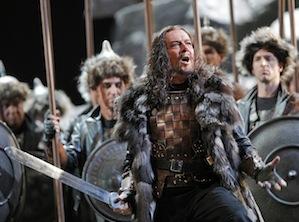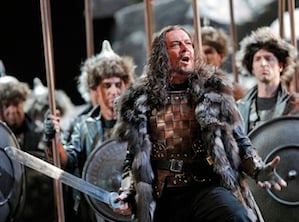
Photos by Cory Weaver
Verdi's Attila is a strange animal. First seen at La Fenice, Venice, in 1846, just 15 years after the premiere of Bellini’s Norma, the structure of its arias and ensembles reflect the recent bel canto past even as its powerhouse writing proclaims the new voice of Italian opera.
Although Attila may have held great resonance for 19th-century Italians struggling for independence from Northern Italy’s Austrian rulers, it soon fell from favor. Not long after reaching New York City in 1850, and San Francisco in 1856, Temistocle Solera and Francesco Maria Piave’s melodramatic pastiche of historical fact and mythology more or less disappeared for close to a century, until its revival at the Venice Festival of 1951. On recording, besides a single, unforgettable 1930 performance of the great Act III trio, “Te sol, te sol quest’ anima,” sung by the unbeatable team of Elisabeth Rethberg, Beniamino Gigli, and Ezio Pinza, it lay virtually ignored until the latter half of the 20th Century.
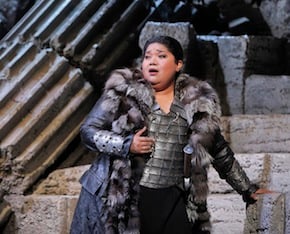
That is a shame, because Attila is filled with one showstopper after another. While their presentation is rather formulaic — virtually all characters introduce themselves with a big aria, which is often divided into an opening section and faster, technically demanding cabaletta — the music for soloists and chorus is stunning. Sometimes one character begins an aria, and then two sing the cabaletta, but the formulaic progression nonetheless provides limited possibilities for imaginative staging.
A main reason for the opera’s fall from grace, besides its static progression and surprisingly anti-climactic denouement, is the near-impossible demands it places on its singers. All four principals — Attila (bass), the conquering Hun with a heart; Odabella (soprano), his prisoner, unwilling wife, and assassin; Ezio (baritone), his Roman adversary; and Foresto (tenor), another foe and lover of Odabella — are warriors. The only one who falters is Attila, and he does so with more dignity and honesty than the other three can summon.
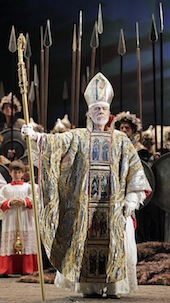
You cannot sound like a second-rate warrior in this opera and pull it off with aplomb. Powerhouses such as Samuel Ramey, who recorded Attila with a superb cast in 1989, are hard to come by these days. San Francisco Opera has one, in the form of Ferruccio Furlanetto in the title role. The veteran bass may be 63, but he sings with the rock-solid steadiness, shine, and beauty of someone half his age. He may tend to sacrifice legato to declamation, but he does so in ways that are musically apt and dramatically defensible. A hulking presence onstage, with the bent over posture of a giant approaching defeat, Furlanetto’s magnificent portrayal is a triumph.
The other principals, at least on opening night, were not quite in the same league. Venezuelan Lucrezia Garcia scored a huge triumph as Odabella at La Scala last year when she stepped into the same production. In her SFO debut, however, she sounded thin, girlish, somewhat squeaky lower in the range, and not entirely secure as her tone fattened farther up. After hurtling out her high notes in the Prologue’s great soprano scena, “Allor che i forti corrono … Da te questo or m’è concesso,” she occasionally faltered on high and sounded hoarse at the bottom of her range. Did she over-sing for opening night, or is she basically a lyric soprano who is forcing her instrument? Time will tell.
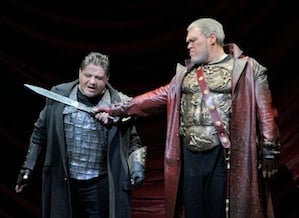
Hawaiian baritone Quinn Kelsey (Ezio) sounded somewhat throaty in his opening scenes, but opened up handsomely as the opera progressed. His sneering face telegraphed defiance, but the voice lacked sufficient dark menace. In his SFO debut, Mexican tenor Diego Torre seemed to husband his resources early on; only in the second and final acts did the beauty and power of his ringing instrument truly emerge. The graduate of Los Angeles Opera’s Domingo-Thornton Young Artist Program has great potential; let us hope more is to come.
Merola graduate and San Francisco Opera debut tenor Nathaniel Peake (Uldino) sang with a sweetness that suggested Mozart more than Verdi. That’s fortunate, given that he performs Tamino in this summer’s Magic Flute. It was deeply moving to see Ramey return to San Francisco Opera, perhaps for the last time, in the opera that he championed. In the small role of Pope Leo I, he sang with the strength of old, but with a pronounced wobble that proclaimed the time has come.
Equally moving was the end-of-performance ceremony, in which David Gockley awarded chorus director Ian Robertson with the coveted San Francisco Opera Medal for his 25 years of service. Need I say that the chorus performed superbly? Standing nearby was Ramey, who received the same award in 2003.
We are blessed to have Nicola Luisotti in San Francisco. Tempos were ideal. While he modulated volume to allow the principals to shine heroically, the orchestra spoke with eloquence, especially during the musically arresting storm scene and in key dramatic moments.
Director Gabriele Lavia, famed in Italy for his Shakespearian portrayals, created this production with theater foremost in mind. Sets are constructed to favor singers and large choral assemblages, and undoubtedly had even greater visual impact on La Scala’s wider stage. I’m not giving away what happens in the final act, but Lavia’s use of the theater as metaphor as the setting progresses from Attila’s time to our own comments eloquently on the state of the arts in contemporary times.
The opera isn’t perfect, nor is this cast’s singing, and most of the arias aren’t whistle-ready ditties. But to broaden your understanding of Verdi’s genius, and witness a great Verdi bass still in his prime, I wouldn’t miss Attila.

